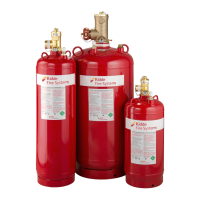General Information
October 2014 1-2 06-236115-001
1-2 SYSTEM DESCRIPTION
1-2.1 General
Kidde ECS Systems are used to suppress fires in specific hazards or equipment located where
an electrically non-conductive agent is required, where agent cleanup creates a problem,
where extinguishing capability with low weight is a factor and where the hazard is normally
occupied by personnel. Kidde ECS Systems are intended to protect the following:
• Data processing facilities
• Telecommunications facilities
• Process control rooms
• High value medical facilities
• High value industrial equipment areas
• Libraries, museums, art galleries
• Anechoic chambers
• Flammable liquid storage areas
HFC-227ea systems are designed for the following classes of fire:
• Class A Surface Type Fires; Wood or other cellulose-type material
• Class B; Flammable liquids
• Class C; Energized electrical equipment
For hazards beyond the scope described above, the designer must consult with Kidde and NFPA
2001, on the suitability of HFC-227ea for the protection, necessary design concentration and
personnel exposure effects from that concentration.
HFC-227ea shall not be used on fires involving the following materials, unless they have been
tested to the satisfaction of the Authority Having Jurisdiction:
1. Certain chemicals or mixtures of chemicals, such as cellulose nitrate and gunpowder, that
are capable of rapid oxidation in the absence of air.
2. Reactive metals such as lithium, sodium, potassium, magnesium, titanium, zirconium, ura-
nium and plutonium.
3. Metal hydrides.
4. Chemicals capable of undergoing autothermal decomposition, such as certain organic per-
oxides and hydrazine.
1-2.1.1 Operating Temperature Range Limitations
The operating temperature range for all components used in the Kidde ECS Systems is 32°F
to 130°F (0°C to 54°C). The components are tested within this range and may not perform as
specified outside this range.
1-2.1.2 Agent Storage Container Temperature Range Limitations
The temperature of the location for the agent storage containers depends on the design of the
system.
1-2.1.2.1 Balanced System Agent Storage Container Temperature Range
In balanced systems, where agent flow through each nozzle is equal, the agent cylinder
storage temperature range is 32°F to 130°F (0°C to 54°C).

